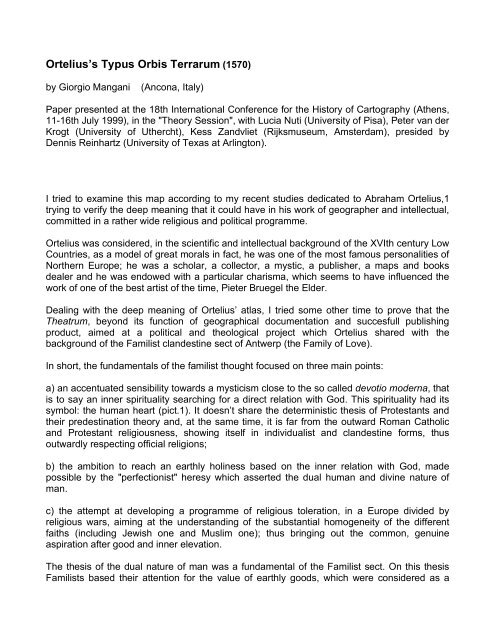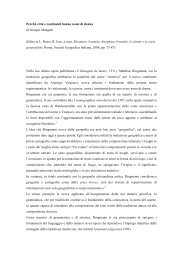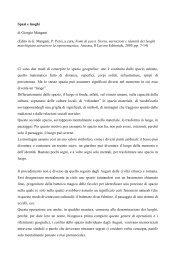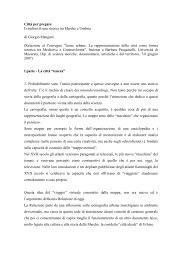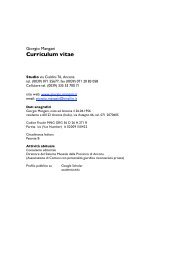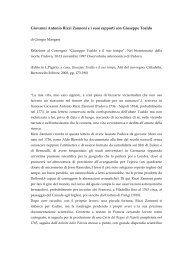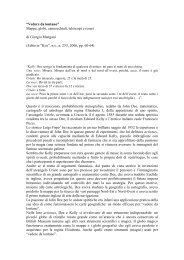Ortelius's Typus Orbis Terrarum (1570)
Ortelius's Typus Orbis Terrarum (1570)
Ortelius's Typus Orbis Terrarum (1570)
Create successful ePaper yourself
Turn your PDF publications into a flip-book with our unique Google optimized e-Paper software.
Ortelius’s <strong>Typus</strong> <strong>Orbis</strong> <strong>Terrarum</strong> (<strong>1570</strong>)<br />
by Giorgio Mangani<br />
(Ancona, Italy)<br />
Paper presented at the 18th International Conference for the History of Cartography (Athens,<br />
11-16th July 1999), in the "Theory Session", with Lucia Nuti (University of Pisa), Peter van der<br />
Krogt (University of Uthercht), Kess Zandvliet (Rijksmuseum, Amsterdam), presided by<br />
Dennis Reinhartz (University of Texas at Arlington).<br />
I tried to examine this map according to my recent studies dedicated to Abraham Ortelius,1<br />
trying to verify the deep meaning that it could have in his work of geographer and intellectual,<br />
committed in a rather wide religious and political programme.<br />
Ortelius was considered, in the scientific and intellectual background of the XVIth century Low<br />
Countries, as a model of great morals in fact, he was one of the most famous personalities of<br />
Northern Europe; he was a scholar, a collector, a mystic, a publisher, a maps and books<br />
dealer and he was endowed with a particular charisma, which seems to have influenced the<br />
work of one of the best artist of the time, Pieter Bruegel the Elder.<br />
Dealing with the deep meaning of Ortelius’ atlas, I tried some other time to prove that the<br />
Theatrum, beyond its function of geographical documentation and succesfull publishing<br />
product, aimed at a political and theological project which Ortelius shared with the<br />
background of the Familist clandestine sect of Antwerp (the Family of Love).<br />
In short, the fundamentals of the familist thought focused on three main points:<br />
a) an accentuated sensibility towards a mysticism close to the so called devotio moderna, that<br />
is to say an inner spirituality searching for a direct relation with God. This spirituality had its<br />
symbol: the human heart (pict.1). It doesn’t share the deterministic thesis of Protestants and<br />
their predestination theory and, at the same time, it is far from the outward Roman Catholic<br />
and Protestant religiousness, showing itself in individualist and clandestine forms, thus<br />
outwardly respecting official religions;<br />
b) the ambition to reach an earthly holiness based on the inner relation with God, made<br />
possible by the "perfectionist" heresy which asserted the dual human and divine nature of<br />
man.<br />
c) the attempt at developing a programme of religious toleration, in a Europe divided by<br />
religious wars, aiming at the understanding of the substantial homogeneity of the different<br />
faiths (including Jewish one and Muslim one); thus bringing out the common, genuine<br />
aspiration after good and inner elevation.<br />
The thesis of the dual nature of man was a fundamental of the Familist sect. On this thesis<br />
Familists based their attention for the value of earthly goods, which were considered as a
manifestation of the divine benevolence; this attitude reflects, somehow, Ortelius’ motto<br />
contemno et orno (I despise the world, but, at the same time, I honour it with my historical and<br />
geographical work, which celebrates nature).<br />
Altough it was a Familist fundamental, this conviction was also shared by other forms of<br />
individual and moderate religiousness, such as the one of Mercatore, who, as a matter of fact,<br />
theorize it.<br />
The figure of Atlas who held the globe represented on the title page of Atlas was in fact an<br />
emblematic figure of this religious conviction, which Ortelius and Mercator had in common,<br />
about which the geographer from Rupelmunde had treated in his commentary on the Epistle<br />
to Romans. Mercator’s Atlas was, actually, a governor of Mauritania, who became a god,<br />
thanks to his work; so he was a man who won immortality by his earthly work, as Familists<br />
asserted as regards the value of good actions carried out during one’s life.<br />
At the times of the first elaboration of Ortelius’map, in a letter to Joannes Vivianus dated<br />
1573, Mercator described his cosmological model which was based on the thesis of the dual<br />
human and divine nature of man; the model was called "<strong>Typus</strong> universitatis", and the word<br />
"typus" is re-used by Ortelius for his map, thus bringing out the importance of the idea of<br />
model in comparison with the idea of representation, better esemplified by the word Imago.<br />
The cosmological model of Mercator was based on the mystic idea of letter Y (pict. 2-3),<br />
which represented the narrow road to salvation and the large one to perdition. Once more<br />
free will was the distance point between Mercator and Ortelius’ religious ideas and the<br />
Protestant ones widespread in the XVIth century Low Countries, the latters asserting the<br />
thesis of predestination.. According to Mercator, <strong>Typus</strong> universitatis, that is to say the deep,<br />
ethical and cosmological structure of the world, was an enormous Y, whose long and narrow<br />
side connected earth with empyrean, whereas the shorter and large side took to nothingness.<br />
So, Y represented a sort of crossroads where man and his earthly life have to face the<br />
problem of choice, according to their free will, between good and evil, beetwen sin and<br />
salvation.<br />
Perhaps now we can better understand the Ciceronian quotation that Ortelius introduces on<br />
his map which inaugurates the Theatrum orbis terrarum: the <strong>Typus</strong> orbis terrarum:<br />
Quid ei potest videri magnum in rebus humanis, cui aternitas<br />
Omnis, totiusque mundi nota sit magnitudo.<br />
It is a key concept which enables us to understand the meaning of the map that, according to<br />
Ortelius’ attitude, acts as a symbol (all his maps are symbols) for the following reasons:<br />
a) its placing at the beginning of the atlas;<br />
b) the interactive relation between the Ciceronian passage and the decoration of the map,<br />
that is to say the light-blue background on which earthly globe is set, filled with clouds;<br />
c) the clear peculiarity of "cosmographical meditation" – as Mercator called it – that comes out<br />
from a general reading of the map, according to Ortelius’ culture and sensbility, as I tried to<br />
point out in some of my previous works.<br />
First of all the image of earth is placed in a cloudy universe, presented to the spectator as a<br />
"world seen from the outside"; it is something like the idea of the stoical theatrum mundi,<br />
where gods looked at men’s life as if they were spectators of a theatre comedy or tragedy.<br />
On the map, however, we can also find a Ciceronian quotation that transfers man’s condition
in a divine sphere, at the same level which was originally reserved to the gods of the ancient<br />
tradition.<br />
If we compare a passage of chapter XXVI of the Liber de sapiente by Charles De Bovelles<br />
(1511) with the Ciceronian quotation, we notice that both the passages celebrate a "divine"<br />
idea of man which was received by North European mysticism according to the perfectionist<br />
thesis widespread among protestant movement.<br />
God saw that there wasn’t any specatator of the whole; there wasn’t a universe eye irradiated<br />
by the ethereal fires shining in the sky, the sublime lights and the firmament stars;there wasn’t<br />
any spectator illuminated by the sidereal tresholds of the intelligible world, full of infinite light,<br />
enriched without respite with their radiance, as if he were son of the whole world, its natural<br />
image, peace and armony of the whole…<br />
Man plays a divine role, even in his function of spectator, thus sanctifying the study of nature<br />
("geography, eye of history", as Ortelius wrote in the Paregon’s title page).<br />
The map <strong>Typus</strong> orbis terrarum appears for the first time in the first edition of the Theatrum<br />
(<strong>1570</strong>). As everybody knows it isn’t the first cartographic work by Ortelius, who has already<br />
published, between 1564 and 1565, the cordiform map of the world and the ancient Egypt<br />
map; in 1567 he made a map of Asia, probably still in cordiform projection.<br />
The world map of 1564 probably took as a model another cordiform map by Mercator, dated<br />
1538, the <strong>Orbis</strong> Imago. It was published in Antwerp, by the publisher Gerard De Jode (who<br />
continued to print it, inserting it, in another engraving, in his Speculum orbis terrarum, pict. 4)<br />
who became rival of Ortelius when the latter decided to publish the Theatrum, thus spoiling<br />
their relations.<br />
This certainly is a good reason for justifying the presence, at the beginning of Ortelius’atlas, of<br />
another map, but probably it is also caused by the publication, in 1569, of Mercator’s map,<br />
with his new projection (ad usum navigantium) which should have confirmed the end of the<br />
cordiform projection.<br />
However, the map which opens the Theatrum continues to have its symbolic function and to<br />
represent a deep meaning very close to those that I tried, elsewhere, to attribute to<br />
Ortelius’map dated 1564. (Picture 4)<br />
In fact, the latter, expressively heart-shaped, represented the microcosmical dimension of<br />
earth (and the heart was the symbol of the sect). In human heart good and evil were fighting a<br />
battle, such as, on earth, man won salvation by his work. (Girolamo Cardano, as John Dee<br />
pointed out, used to define earth as Cor coeli, because of its similarity with the function of<br />
heart in the middle of bloodstream). So, once more, the celebration of free will, of the value of<br />
good actions, of the ethical choice between the narrow road leading to good and the large<br />
one leading to sin. That is a principle which Familist iconography represented in a didactic<br />
way in a clandestine print dated 1576, in which the trip of a soul, from the expulsion from<br />
Earthly Paradise till the recovery of spiritual salvation, was inscribed in a heart-shaped world,<br />
as a symbol of charity and of the sect itself (Familia Charitatis, pict. 5).<br />
<strong>Typus</strong> orbis terrarum doesn’t represent any longer the heart-shaped globe, but its emblematic<br />
dimension is pointed out through different signs.<br />
So, in the first state of the map, Ciceronian quotation draws the tradition of the theatrum<br />
mundi. In the third state of the map, made in about 1587 and appeared in the Theatrum from<br />
1589 till 1612,4 this moral and emblematic aspect is further accentuated, by the including of
four more quotations in as many medallions set at the engraving‘s sides, and by a lively<br />
grotesque decoration, which replaces the light-blue background of the clouds, without loosing<br />
sight of the dimension of the "world seen from the outside".<br />
As Rodney Shirley pointed out,5 geographic integrations in this third state are modest; they<br />
only adopt a more correct form of South America and introduce Solomon Islands, without<br />
inserting the more recent discoveries, thus leading to the exclusion of the map from the<br />
Principall Navigations by Hakluyt, in 1592.<br />
As Gillis pointed out,6 the revision of the map is more aesthetic than scientific, thus<br />
accentuating its nature of theological-cosmographical emblem.<br />
About new quotations, we have to say that two are by Seneca and two are by Cicero; two of<br />
them (one by Cicero and one by Seneca, on the left side) recall the vanitas of human<br />
condition , the two others (one by Cicero and one by Seneca on the right side) confirm the<br />
providential function of contemplation and comprehension of creation, as we have seen in the<br />
passage by Charles de Bovelles.<br />
Homines hac lege sunt generati, qui tuerentur illum globum, quem in hoc templo medium<br />
vides, quae terra dicitur (Cic.)<br />
Equus vehendi causa, arandi bos, venandi et custodiendi canis, homo autem ortus ad<br />
mundum contemplandum (Cic.)<br />
Hoc est punctum quod inter tot gentes ferro et igni dividitur, o quam ridiculi sunt mortalium<br />
termini (Sen.)<br />
Utinam quaemadmodum universa mundi facies in conspectum venit, ita philosophia tota<br />
nobis posset occurrere (Sen.)<br />
Both the concepts represent the dual human and divine nature of man and they symbolize his<br />
condition of intermediary between matter and spirit, acording to the Christian cabalistic<br />
principles. The presence of a quotation taken from the Somnium Scipionis (Homines hac lege<br />
sunt generati. Qui tuerentur illum globum, quem in hoc templo medium vides quae terra<br />
dicitur) further points out the recall to hermetic tradition and to the Prisca Theologia.<br />
But the four quotations, in groups of two, are a mere repetition of the motto which appears in<br />
Ortelius’ emblem, Contemno et orno, which will also be engraved in his sepulchral monument,<br />
inspired from Justus Lipsius, and printed in the atlas after his death (pict. 6).<br />
The first quotation by Seneca on the left side of the map, introduces a theological reference to<br />
the thought of the German mystic Sebastian Franck, very close to Ortelius’ sensibility. Franck<br />
really influenced the thought of the Familist sect. He wrote the first German geography book,<br />
Weltbuch, printed in Tubing in 1534, where he asserted a prophetic idea of human history and<br />
geography, considering foolish the division of the states and the political differences, giving<br />
that man aspired to universal brotherhood. This is a very important subject for the<br />
interpretation of the deep meaning of Ortelius’collection, which aims at "collecting" the world<br />
in an organic "whole", symbolically bound in a volume, as we can see in the poems and in the<br />
introductory apparatus of the atlas (Hoc est punctum, quod inter tot gentes ferro et igni<br />
dividitur, o quam ridiculi sunt mortalium termini).<br />
In the introductory chapter of the Theatrum Ortelius recalls, once more, the ephemeral<br />
dimension of earth (contemno) compared to the rest of the universe, but, at the same time, he<br />
points out its function of place where mankind must play, according to Stoical and then<br />
Christian tradition of the Theatrum mundi, his comedy, which means, according to him, the
conquest of salvation (orno): haec est materia gloriae nostrae.<br />
The reference to the miserable human condition is pointed out, in turn, by the quotation which<br />
closes the passage. It is the same which is printed in the engraving, where there is 1564<br />
Ortelius’map, inscribed on the had gear of a jester belonging to 1580-90 neostoical<br />
background of Antwerp (picture 7). This is very well known in the history of cartography<br />
ambient.<br />
Hic est mundi punctus et materia gloriae nostrae, hic sedes, hic honores gerimus, hic<br />
exercemus imperia, hic opes cupimus, hic tumultuatur humanum genus, hic instauramus<br />
bella, etiam civica.<br />
So, Ortelius’cordiform map entered moral iconographic tradition. The choice to adopt a new<br />
projection for the map of the world of the Theatrum orbis terrarum depended both on the legal<br />
troubles with the publisher De Jode and on a probable usury of that figure and projection<br />
which had an ethical dimension, thus becoming, especially after the new map by Mercator of<br />
1569, inadequate for the new scientific context where it has to appear.<br />
We have to consider that the image of heart, also symbol of the Familist sect, became a little<br />
compromising in the Low Countries territories. In fact they were under Calvinists influence,<br />
who were notoriously opposite to give a salvation value to good actions, represented by<br />
chariry. The map of Flanders which appears in the Ortelius’ Theatrum, for example, presents<br />
two different states, one with a heart-shaped decoration, stored in Leiden, and the other one<br />
without this decoration, stored in Amsterdam, one of the cities mainly governed by<br />
Protestants.<br />
Nevertheless the <strong>Typus</strong> orbis terrarum remained a programmatic manifesto of Ortelius’moral<br />
geography.<br />
In conclusion the map<br />
a) represented Ortelius’ theological, political and moral project of a reconciled world in a<br />
religious toleration system, based on a new sensibility towards man’s dignity, both mystic and<br />
humanistic;<br />
b) represented the dual enigma of human condition, compressed between the vanity of its<br />
miserable condition and the big opportunity, offered by Providence, to be uplift to Divine,<br />
through virtues and inner cultivation;<br />
c) betraied moral statute of Ortelius’ geography (and, consequently, of his atlas), seen as the<br />
eye of history, which was a Reinassance synthesis of experimental culture and ethicalreligious<br />
aspirations, whose meaning was kept and clearly communicated in the title of his<br />
work: Theatrum orbis terrarum.
Notes<br />
1. G. Mangani, Il "mondo" di Abramo Ortelio. Misticismo, geografia e collezionismo nel Rinascimento<br />
dei Paesi Bassi, Modena, Franco Cosimo Panini, 1998; G. Mangani, La signification providentielle du<br />
Theatrum orbis terrarum, in Abraham Ortelius, 1527–1598, Cartographe et humaniste, Turnhout<br />
(Belgium), Brepols Publishers, 1998, pages 93-104.<br />
2. C. De Bovelles, Il libro del sapiente, E. Garin ed., Torino, Einaudi, 1987, chapter XXVI.<br />
3. G. Mangani, Abraham Ortelius and the Hermetic Meaning of the Cordiform Projection, "Imago<br />
Mundi", L, 1998, pages 59-83.<br />
4. M.P.R. van der Broecke, Ortelius Atlas Maps. An illustrated Guide, Westrenen, Hes Publishers,<br />
1996.<br />
5. R. Shirley, The Mapping of the World. Early Printed Maps. 1472-1700, London, New Holland, 1993,<br />
n. 158.<br />
6. J. Gillies, Shakespeare and the Geography of Difference, Cambridge, Cambridge University Press,<br />
1994, pages 70-84.


